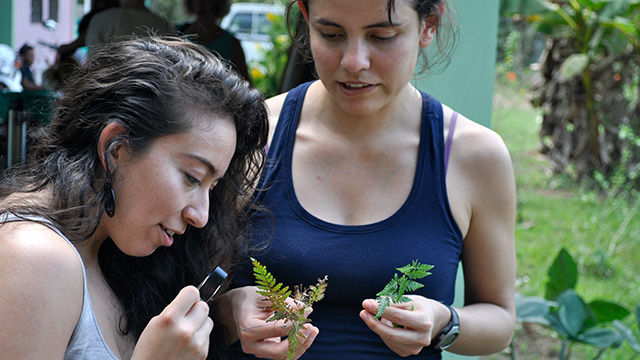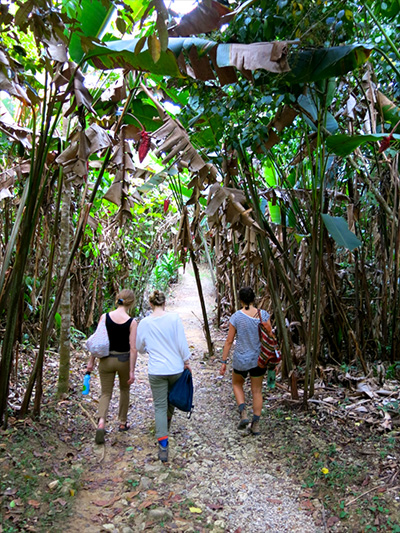In Healing Plants and the People Who Use Them, I ceased to be a walking résumé.
Students in PLHRT 4940, Healing Plants and the People Who Use Them, spent spring break working with and learning from Mayan healers in Belize and herbalists in the Ithaca area. They will provide an overview of their experiences and present their final projects on May 16 from 12:45 p.m. to 1:45 p.m. in 102 Mann Library.
What makes the course special? Instructor Marcia Eames-Sheavly, a senior lecturer and senior Extension associate in the Horticulture Section of Cornell’s School of Integrative Plant Science explains:

The course syllabus for PLHRT 4940: Healing Plants and the People Who Use Them begins with an intention:
- What are the various roles of plants in our lives?
- What is a community, and in that community, what are people’s ways of understanding and knowing?
- And, who are you?
Whatever your answer to these questions, and whatever it includes at this juncture of your life, our hope is that if you intentionally engage in PLHRT 4940, by semester’s end, your ideas of the value of plants…of community…and of self, are going to be changed.
During the first half of the semester, the students participated in diverse classroom activities to prepare them to make the most of their experience. That meant more than just learning how to identify plants. As a team, we engaged students in topics ranging from ethics and cultural sensitivity to appropriate use of technology and how to ask good questions. And teamwork was key. As the students worked and planned together, they learned each other’s strengths and weaknesses. They learned that they didn’t need to know it all if they could work together.
During the 2016 spring break, we divided into two groups. One group traveled to the Toledo District of Belize to work with Mayan healers. The other stayed in Ithaca to work with Tammi Sweet, co-founder of the Heartstone Herbal School.
Depending on the location, the students focused on learning traditional plant medicine and the spiritual ecology undergirding it; preserving the wisdom of indigenous healers and their knowledge of medicinal plants; making preparations ranging from salves to soaps; and preparing a new medicinal plants nature trail. Both groups steeped in reflection about healing plants, the people who use them, and their own journey at these intersections.

In Belize, use of healing plants is a centuries-old tradition that’s being lost because fewer young people are pursuing plant medicine. It’s fascinating that here in the U.S., the interest seems to be exploding. Learning about plant medicine and the people engaged in it has benefits for people around the world, and for the health of our students here at Cornell, too.
Before the course, I had a few friends who studied plants—individuals I met through my cooperative—and had only a vague interest in plants, myself. Now, I have built off that vague interest, learning how everyday plants we walk by on our way to class could actually be useful in our lives. …I have gained friends and developed bonds with individuals who allow me to cultivate this interest further.

Understanding the need for a solid undergirding in anthropological perspective, I invited Charis Boke, Ph.D. candidate in Anthropology, to collaborate in teaching. “I was curious to see how my work as a cultural anthropologist would fit in with plant science,” she recalls. But working as part of our teaching team along with horticulture graduate student Grant Thompson and plant biology graduate student Camila Martinez (who both helped lead the Belize trip) to prepare the students for their experiential spring break work turned out to be “…one of the most stimulating teaching experiences I’ve had. Together we were able to create a robustly reflective and engaging cross-disciplinary learning experience for the students.”
After break, students from both groups tackled practical projects primarily aimed at integrating their new-found interests with specific lay audiences. These took forms ranging from narratives based on interviews with healers to lesson plans, a grant proposal rationale, cookbook recipes, how-to flyers on growing medicinal plants, personal essays, maps, and blending teas to help fellow students cope with stress.
“We opened up a place for them to explore their own passions,” says Boke. “Seeing them latch on to these concrete ways that they can insert themselves into the world of people-plant relationships has been really gratifying.”
I have experienced such a holistic form of learning that the class will continue to follow me and my life path—perhaps even guiding my life’s path into the future.


